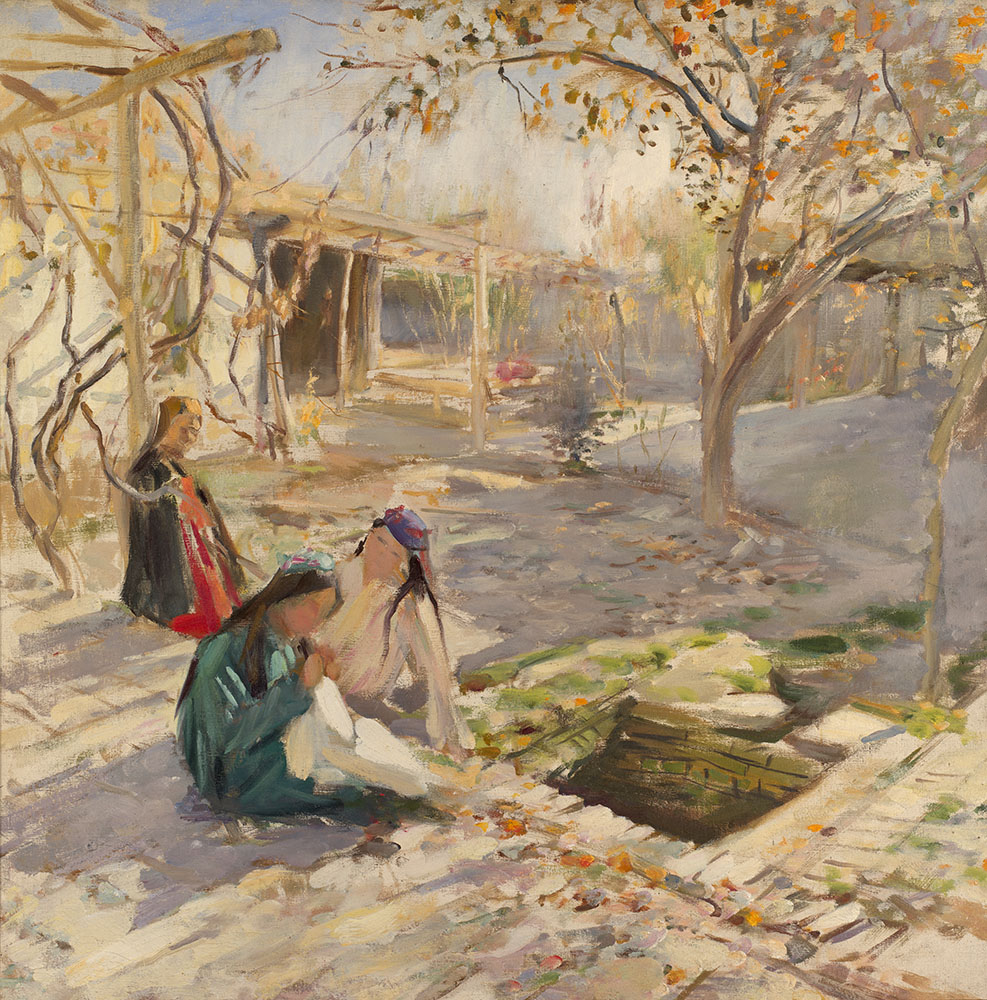MacDougall Auctions 2-3 December 2009
2 December 2009

* 324. BENKOV, PAVEL 1879-1949
Girls Playing by the Artist's House, Samarkand inscribed in Cyrillic and authenticated by M. Leschinskaya, the granddaughted of the artist, on the reverse, c. 1940s
Oil on canvas, 100 by 100 cm.
35,000-45,000 pounds
Provenance: Acquired directly from the artist’s family.
Private collection, Europe.
Authenticity has been confirmed by the expert Dr. Nigora Akhmedova, Tashkent, Uzbekistan.
Literature: Pavel Benkov (1879–1949), Complier M. Leschinskaya-Benkova, The State Museum of Oriental Arts, Moscow, 2009, p. 147, illustrated.
Pavel Petrovich Benkov (1879–1949) was an important figure in XX century art. A brilliant artist and an experienced teacher, he is considered the father of graphic arts in Uzbekistan and also facilitated the fruitful interaction between Russian and European art and that of young, national schools.
Benkov’s career was unique: he was born in Kazan and received his training at the St Petersburg Academy of Art. His initial inspiration was the plastic arts movement that was prevalent in Russian art at the turn of the century, whilst during his short spell in Paris he attended the Julien studio and also became strongly influenced by the French impressionists. In 1929 he went to Uzbekistan and became so enchanted by Central Asia that he settled in Samarkand, where he remained for the rest of his life.
He was already an experienced artist when he arrived in Uzbekistan, and in the beginning he was without a doubt the sole bearer of rich artistic traditions.
Benkov’s work in Uzbekistan was defined by typical impressionist features, such as the search for new ways to convey the poetry of sunlight, beauty and colour. Nature of Uzbekistan became the basis for Benkov’s new and unique impressionist vision, which focused on capturing the light through air and plein air work. Benkov’s mastery truly showed itself as he reinterpreted impressionism by introducing his particular approach to life painting. Benkov used decorative elements to enhance the effects of colour, and saw artistic form as a way of generating new meanings, new expressions of emotion. Thus, his painting was often guided by the technique of non finito, whereby he worked with a total disregard for official canons and relied solely on his artistic instinct.
Bukhara, Khiva and Samarkand, with the colourful hubbub of their bazaars, endless turquoise sky, sun-burnt earth and colourful local characters, are favourite motifs in Benkov’s work, including paintings such as Bazaar in Bukhara, Hauza with Water Carriers, Samarkand, a Courtyard, Girl from Khiva and many others. They are held at the State Tretyakov Gallery, the State Russian Museum, the Uzbekistan State Museum of Fine Arts, and the Savitsky Museum in Nukus. Far from the dull orientalism that savours Eastern exoticism, Benkov’s vision of the East is embodied in his series of works depicting the tiny courtyards of Samarkand. This, in a sense, is an artistic metaphor for the traditional harmony between nature and man, in which the poetry of everyday life and love for life, and its casual, leisurely flow play a crucial part.
Dr. Nigora Akhmedova, Tashkent, Uzbekistan
Notes on symbols:
* Indicates 5% Import Duty Charge applies.
Ω Indicates 20% Import Duty Charge applies.
§ Indicates Artist's Resale Right applies.
† Indicates Standard VAT scheme applies, and the rate of 20% VAT will be charged on both hammer price and premium.